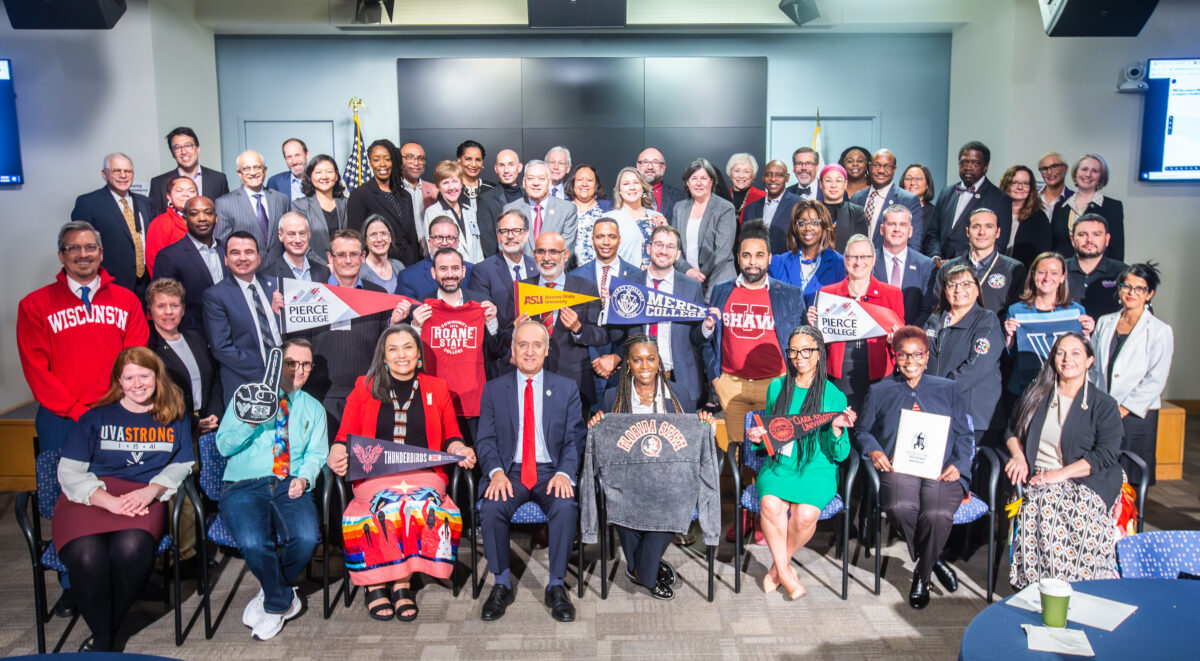How strong institutional partnerships serve transfer students well. Reflections on ED’s Raise The Bar Summit
Published Dec 18, 2023
By: Lauren Bell
Nearly 40% of students transfer from one institution to another at some point during their postsecondary journey, but on average, 43% of credits students already earned are not accepted by their receiving institution. This equates to a loss of time and money. A closer look at transfer outcomes reveals disparities: Among students who start at a two-year institution, Black (28 percent) and Hispanic (37 percent) students transfer to a four-year institution at much lower rates than White students (48 percent). Likewise, students from lower-income backgrounds who start at a community college are less likely to transfer than students from higher-income ones (25 percent vs 41 percent).
The U.S. Department of Education (ED) recognizes the urgent need for clear, supportive institutional pathways to degree completion and recently organized the Raise the Bar Summit at Northern Virginia Community College (NOVA) to explore the intricacies of these processes. The summit brought together 200 diverse higher education leaders, including teams from 11 states, and elevated promising models that make the transfer process more equitable, smooth, and cost-effective for students.
Breakthrough Data Identifies Successful Transfer Partnerships
At the summit, ED released—for the first time ever— data showing how well specific four-year institutions serve community college transfer students across the country. The new analysis examined federal financial aid recipients who began postsecondary studies at a community college in 2014 and analyzed their transfer-out rates and bachelor’s degree completion outcomes eight years later. The analysis sheds light on transfer trends and outcomes at both sending and receiving institutions.
So, what do the data reveal about how well colleges serve transfer students? Top-performing two-year and four-year institutional partnerships showcase policies and practices that can be implemented on other campuses to improve transfer student outcomes. For example, 503 students who started at NOVA in 2014 transferred and completed a bachelor’s degree at George Mason University (GMU) within eight years. The partnership’s success is rooted in the ADVANCE program, which provides focused academic pathways coupled with coaching and other supports for students who want to transfer to GMU. Aligning curricula between institutions can be tough. It requires commitment from faculty and top leaders. But the impact is undeniable: ADVANCE 92% of ADVANCE students attain a bachelor’s degree within two years of transferring.
IHEP’s TransferBOOST Initiative and Affordability Financial Tool
IHEP’s interest in identifying and scaling evidence-based degree completion models stems from an innovative approach designed to provide students with quality, affordable, and well-supported pathways to achieve their dreams of earning a degree. Between 2021 and 2023, IHEP and HCM Strategists partnered with 24 colleges in Arizona, Illinois, and Virginia to examine transfer policies and practices, and reach students with clear and simple messaging about affordable transfer pathways. The multi-year effort –TransferBOOST (Bachelor’s Opportunity Options that are Straightforward and Transparent) – helped formulate lessons other community colleges, four-year institutions, and state leaders can apply in their own contexts to increase student enrollment, retention, and completion. TransferBOOST informed a three-part series of insights.
Five Key Lessons from TransferBOOST:
- Ensuring equitable student transfer outcomes requires consistency and intentionality.
- Serving transfer students well is an essential enrollment (and revenue) strategy.
- Institutions can make transfer pathways affordable and improve their financial stability.
- Schools should communicate jointly about transfer pathways and emphasize benefits.
- Strong state and institutional partnerships are critical to creating stronger transfer pathways.
To further help institutions and state partners strengthen transfer pathways, IHEP and HCM Strategists partnered with rpk GROUP to build the TransferBOOST Affordability Financial Tool. The tool helps colleges and universities evaluate the expenditures and resources needed to establish more affordable transfer pathways. By calculating the potential return on investment from increased student enrollment, retention, and completion through transfers, the tool assists institutions to make informed decisions to support the equitable success of transfer students. Learn how to maximize the impact of the tool and download it here.
A Coordinated Push for Transfer Success
ED, states, community colleges, four-year institutions, and advocates are dismantling administrative barriers transfer students face and building a more supportive and inclusive higher education system. Institutional partnerships, data-driven strategies, and innovative tools are paving the way for a more equitable and efficient transfer process and brighter futures for students.
Learn more about IHEP’s efforts to promote equitable transfer student success through data with the Affordability Financial Tool and read the three-part TransferBOOST research series here.


